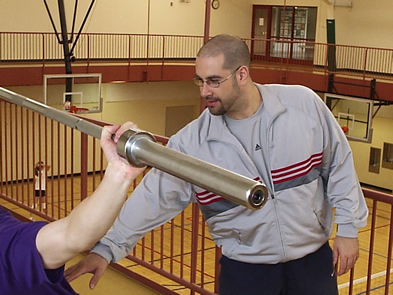Training for Power with Young Athletes
By Wil Fleming
My young athletes are known for explosive power, from middle school volleyball players to football players preparing for the combine all of them out class the competition when it comes to quick bursts of power. Recently I put together a presentation outlining my favorite exercises to do just that. I have shared a brief outline of the topics covered in that seminar in the list below.
1. Hang Clean and Snatch-
You will notice that I did not say the Power Clean or Power Snatch. Power cleans are the staple of most training programs, but the key is by doing this movement from the hang position i.e. with the bar just above your knees. This position is much closer to ones athletes actually use in athetics and athletes have a much greater potential for technically sound lifts.
The snatch must be included because it is such a powerful movement as well and can lend diversity to the program.
2. CHAOS agility drills
Much of the need for power in football comes in the reaction to a movement of the ball or of the defensive player, because of this football players must also have the mental awareness to make explosive movements as a reaction. Credit Coach Robert Dos Remedios for this one, but my favorite training tool for this are CHAOS agility drills (it stands for Conscious to unconscious Have unpredictability Active to Reactive Open drills Slow to Fast). The idea behind it is to have athletes mirror one another in specific patterns first and then to open ended drills with many different movement patterns, more closely replicating the actions of actual game play.
3. Kettlebell Swings
This is a foundation movement for any athlete looking to develop more power. The action in the kettlebell swing is founded on the idea of a hip hinge, this is important because most athletes need to gain better control of the ability to hinge at the hips. Most athletes are very much Quad dominant and are losing out on the potential of their backside. The Kettlebell Swing does a great job of teaching these motions effectively.
4. MB Throws
Using medicine balls in throwing motions (chest pass, Side throws, Throws for distance) is a great way to develop power in the upperbody for young athletes while incorporating the important parts of hang cleans, hang snatches, and Kettlebell swings (hip hinging). Delivering a Medicine ball with force is a great way to engage the core in explosive activities as well, generating force with the lower body must require active core control to deliver the ball with the arms, This transfer of power is important to all sports.
5. Plyometrics
Athletes need to be adept at accelerating and decelerating their own body at maximum speeds. Plyometrics are the first way that athletes can learn to do so. Maximal jumps with a stuck landing will help athletes develop resistance to injury and will simulate many movements in sport.
There is a lot more than just power that goes into becoming athlete. It takes general strength, resistance to injury, proper conditioning and a well prepared mind.
Focusing on power will take athletes a long way towards getting to where they want to be.



